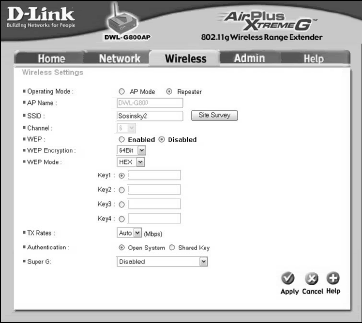You can add additional wireless devices to your wireless network to enable you to cover more area, or to give you greater bandwidth over which to communicate.
You can also extend your coverage by wirelessly connecting two or more LANs. Because very few people have completely wireless networks, nearly all networks start out as wired LANs to which wireless capabilities are added.
Wireless networking can expand your network to places that are either difficult or impossible to run a wire to. Wireless links can serve as bridges between two LAN islands. Given the right antennas, you can create wireless network links up to 10 miles in distance with 802.11 technology.
That makes wireless technology useful for bridges across a campus, a city, a county, or anywhere else where you need a long distance or temporary link. Given these uses of wireless networking technology it is the natural next step to want to extend your network’s range further.
Perhaps you have a bedroom on another floor at the far end of your home or you want to extend your network out to your patio where you can work in the sunshine; or perhaps you have a network running in your shop or guest home that you want to connect to another network in your house.
In this tutorial, you’ll learn how you can create multi-zone networks in your home and small office. Additional networks and zones mean additional possible points of entry for outsiders trying to gain unwanted access to your systems. That’s true of any situation where you add complexity to a computer network.
So we’ll also take a look at what the security concerns are and how you can manage them. However, having multiple networks also means that you have additional tools to make things tougher for the bad guys, too.
By applying techniques like protocol isolation (proxy servers), firewalls, software traps such as honey pots, and so on, you can make your primary data networks more secure.
Expanding with Repeaters
Let’s start with what is perhaps the simplest way to extend your wireless network’s reach, by adding repeaters. A repeater is a device that amplifies the signal from a wireless network and operates in a combination of bridging and access point modes.
A repeater takes a signal from an wireless access point or router and broadcasts it to wireless clients. We’re particularly fond of repeaters because they are simple to install and to move around as you need to.
A repeater does not connect to an Ethernet port, except for when you are configuring it, so these devices are entirely portable. A repeater can help you get your wireless signal to a remote bedroom, the basement, or your patio, and may allow a small network to use a single access point.
Repeaters take the same settings as the device they are repeating and they don’t add much to the complexity of a wireless network. Strangely, most wireless books and articles don’t spend a lot of time describing repeaters, probably because they are only recently appearing in consumer wireless devices.
Normally you don’t buy a repeater per se; you buy an access point that can be placed into repeater mode. The first generation of access points did not offer a repeater mode, but most of the current crop of access points do have this feature.
A repeater is also called a range extender and, depending upon the protocol and placement, can amplify the signal 50 percent or more. The theoretical specification for the range of the DWLG800AP repeater is from 328 feet (100 meters) indoors up to 1,312 feet (400 meters) outdoors.
You’ll typically get less than that for any real application where there are interferences. Given the variance in environment and signal strengths, no vendor publishes range numbers that are actually meaningful to most people.
One recent review of the D-Link DWL-900AP found that the range of a signal was increased about 160 percent. The access point signal was lost at 55 feet from the router/access point without a repeater.
With this particular repeater, the reviewer was able to get a signal strength of 72 percent at 140 feet. So this technology does work and is worth considering when you want to keep things simple.
The D-Link DWL-G800AP is an example of an access point/repeater. This particular repeater amplifies an 802.11g and 802.11b signal. This particular repeater is meant to mate up to D-Link’s AirPlus Extreme G series of routers and access points, so it’s a good idea to check for compatibility when you are purchasing repeaters.
Remember that the use of access points as repeaters isn’t really part of the 802.11 standard so, as is often the case, you should try to use the same manufacturer’s equipment in your setup.
When you use it for this series, these repeaters enable you to use 128 WEP and Wi-Fi Protected Access (WPA) security. You configure this repeater through the browser-based utility shown in Figure 1.
When the DWL-G800AP is an access point, a repeater takes a different channel from the other adjoining access points, but when it’s in repeater mode it needs to be set to the same channel. To be part of the same network it must use the same SSID settings.
Repeaters do lower throughput, which is one reason that they aren’t heavily used on enterprise networks or when there is heavy wireless network traffic. You are asking the device to both amplify a signal as well as broadcast it, which doubles the number of frames that the device transmits.
But for a home or a small office that isn’t limited in wireless bandwidth, this is a good solution.
